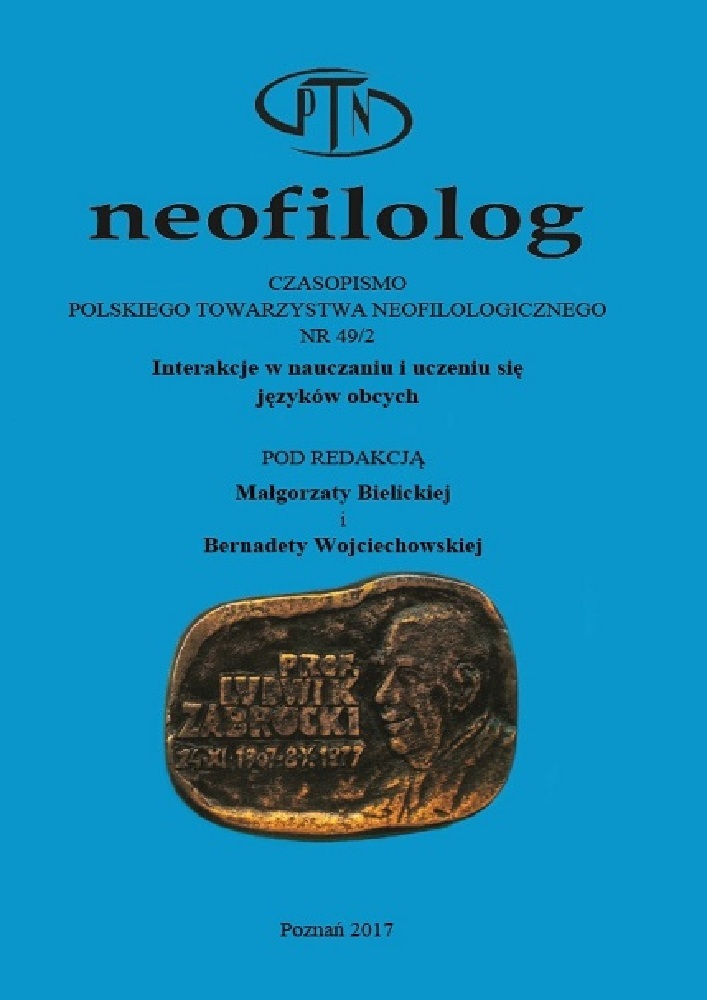Abstrakt
Foreign language classes at university should enhance not only knowledge of foreign languages but with the use of different methods, should also develop skills of communication strategies, which are very important to compensate for deficits in communication. These strategies are indispensable for language learners irrespective of their level of proficiency. The objective of the study described in the present paper is to explore the communication strategies used by Polish students at different levels of knowledge of Italian. Data was collected by two types of questionnaires, one including two open-ended questions. The other was based on a Likert-scale method which examined the frequency of usage of avoidance strategies, verbal and non verbal strategies, as well as the strategy of transfer. Emphasis was placed on the relationship between the use of types of communication strategies and students’ level of proficiency. In the final part the author recommends types of lexical exercises which should be practised during classes to help students to develop their communicative skills.
Bibliografia
Canale, M. i M. Swain. 1980. „Theoretical bases of communicative approaches to second language teaching and testing”. Applied Linguistics 1: 1-47.
Corder, P. S. 1982. Error Analysis and Interlanguage. Oxford: Oxford University Press.
Jakobson, R. 1989. W poszukiwaniu istoty języka. Wybór pism, t. 1. Warszawa: PIW.
Morytz, J. 2017. „Nauczanie kreatywności podczas lektoratów języka ekonomicznego”(w druku).
Pawlak, M. 2014. „Strategie komunikacyjne w nauce języka obcego – próba integracji perspektyw”. Konińskie Studia Językowe 2 (1): 11-33.
Piotrowski, S. 2013. „O strategiach w komunikacji egzolingwalnej w warunkach formalnych”. Lingwistyka Stosowana 8: 117-131.
Piotrowski, S. 2016. „Strategie komunikacyjne, czyli jak uczący się radzą sobie z deficytami leksykalnymi w klasie języka obcego”. Języki Obce w Szkole 1: 26-31.
Porquier, R. 1979. „Stratégies de communication en langue non-maternelle”. Travaux du Centre de Recherches Sémiologiques de Neuchâtel 33: 38-52.
Rada Europy. 2003. Europejski system opisu kształcenia językowego: uczenie się, nauczanie, ocenianie. Warszawa: Wydawnictwa CODN.
Selinker, L. 1972. „Interlanguage”. International Review of Applied Linguistics 10: 209-231.
Tarone, E. 1977. „Conscious communication strategies in interlanguage”. (w) On TESOL’77: Teaching and Learning English as a second Language. (red. H. Brown, C. Yorio i R. Crymes). Washington, DC: TESOL, str. 194-203.
Wilczyńska, W. 1999. Uczyć się czy być nauczanym? O autonomii w przyswajaniu języka obcego. Warszawa–Poznań: Wydawnictwo Naukowe PWN.
Licencja
Prawa autorskie (c) 2017 Jolanta Morytz

Utwór dostępny jest na licencji Creative Commons Uznanie autorstwa – Bez utworów zależnych 4.0 Międzynarodowe.
Przedstawiany utwór (artykuł) upubliczniany jest na podstawie umowy z autorem i na licencji Creative Commons Attribution-NoDerivatives 4.0 International (CC BY-ND 4.0).
Użytkownicy mają obowiązek podania wraz z rozpowszechnionym utworem, informacji o autorstwie, tytule, źródle (odnośniki do oryginalnego utworu, DOI) oraz samej licencji;
- bez tworzenia utworów zależnych,
- utwór musi być zachowany w oryginalnej postaci.
Uniwersytet im. Adama Mickiewicza w Poznaniu zachowuje prawo do czasopisma jako całości (układ, forma graficzna, tytuł, projekt okładki, logo itp.).
